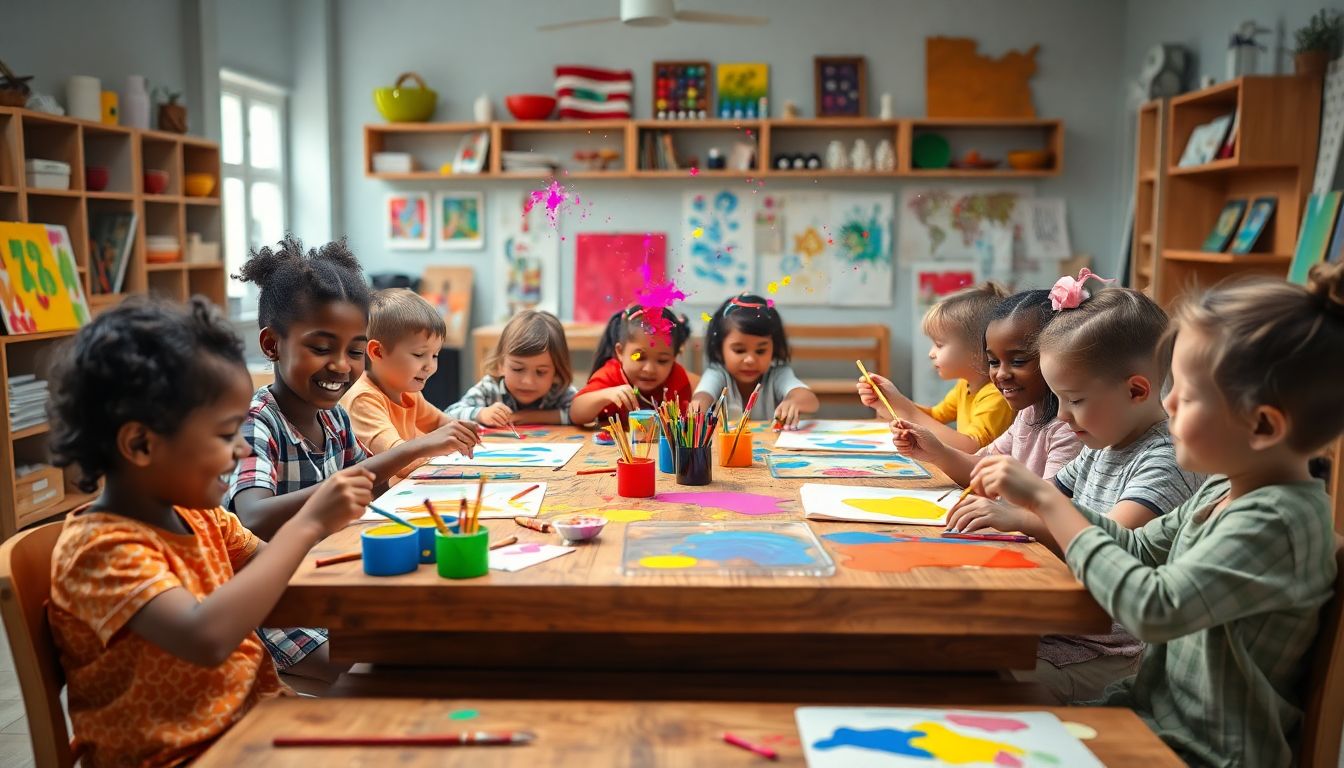Introduction
Not only is painting fun for kids, but also it plays an important role in development. Through painting, children can enhance motor skills, stimulate creativity, and express emotions. Parents and teachers see a good benefit in hands-on activities that spark the mind of the child.
For the past few years, there has been a stay-at-home or homeschooler favorite in the guise of DIY paint crafts. They turn simple materials into hours of creative fun. Here is an article that presents fun painting crafts, precautions, ideas for all ages, and advice from experts to help you help the budding artists in your life grow.
Why Painting Crafts Are Beneficial for Kids’ Development
Painting is greater than adorable images; it hones a great deal of talent. When children focus on painting, they listen better and solve problems. They become smarter brains since they have to mix paint and arrange things.
Painting also helps emotionally to express without words. Painting empowers them and makes them feel accomplished. Children also become patient and respectful of instructions while doing a job.
Studies have shown that arts education facilitates brain development. Arts children gain higher grades and more self-confidence. arts and crafts promote their development more so than books ever could.
General Materials for Successful and Safe Painting Projects
Materials Suitable for Each Age Group
Choosing the right supplies allows children to work safely and with confidence. Toddlers and preschoolers need to have non-toxic paint and large brushes. They are easy to use and safe in case of tasting by mistake.
Beginner children can play with washable tempera paint or water paint. More experienced children can use acrylic paint for richer color.
Safety Tips and Best Practices
Be with small children when painting. Place paints, brushes, and water cups within reach but out of the way of mischief. Paint with hypoallergenic, non-toxic paint to avoid allergic reactions.
Paint where there is good ventilation, and wear old clothes or an apron to avoid clothing getting stained. Safety first, remember!
Setting Up a Creative Space
Create a cozy home or school painting corner. Set up a small table and wipe-down-friendly mats or paper towels. Keep supplies in labeled bins or trays, making them simple to grab.
The nook excels at enjoying painting time and keeps messy circumstances contained, so the fun won’t turn into chaos.
Fun Painting Crafts for All Age Groups
Toddler Painting Projects
Toddler love to play with texture. Washable or edible finger painting is great for sensory play.
Big sponges and brushes make sloppy painting a snorty adventure. Accent simple projects that develop motor skills and make them eager to create.
Preschool Painting Projects
Children at this age love to find things out. Stamping using household objects, like potatoes or bottle tops, makes great patterns.
Watercolor resist art, which crayons resist watercoloring, can be easily created and taught regarding color and process.
Elementary School Artistic Craft
The older children are ready for abstract canvas paint using acrylics. They learn blending and layering.
Painting plants or planters for the garden brings projects outdoors. Allowing embellishment and skill practice on each project.
Tween and Teen Advanced Paint Projects
Teenagers appreciate more advanced projects. Blending painting and collage or other crafts challenges imagination.
They can make mini artwork or personalized art to hang in their bedrooms. This kind of art encourages genuine personal expression.
Themed Painting Crafts to Increase Participation
Seasonal and Holiday Crafts
Paint pumpkins in fall, or snowmen and winter scenes in winter. Valentine themes and hearts are great to show love.
Matching crafts with seasons keeps projects up to date and interesting, connecting art with holidays and events.
Nature-Inspired Projects
Paint animals, flowers, and landscapes. These allow the children the opportunity to relate with nature from the inside.
Employing natural resources such as leaves or stones in painting introduces the environment-friendly element that invokes respect for nature.
Learning and STEM Painting Crafts
Mix paint to acquire science through colour experiments.
Projects such as melting ice using watercolor illustrate real science. Intersecting arts and learning makes the two classes more engaging overall.
Enhancement Tips for Painting Crafts to be Engaging and Accessible
Make projects interactive by narrating them. Invite children to do paintings based on themes or areas of interest.
Develop big projects such as group murals or painting walls that require collaboration.
Alter activities for children with disabilities by decomposing steps or providing sensory accommodations.
Providing background music or commentary adds activity liveliness to enable the kids to have an enhanced experience.
Don’t forget, the point is self-expression and enjoyment. Provide children time to play and learn what they are capable of doing without striving for perfection.
Craft painting generates an entire new world of education and entertainment for kids. They learn things they require through playing freely around. By choosing safe materials, activities for their age group, and encouraging creativity and imagination, we develop confidence and motor skills in kids.
Exploring new activities and merging seasonal, nature, and STEM subjects maintains art interesting. From finger paint for young preschoolers to complicated mixed media for high school students, the focus is to pay respect to creativity.
Go to local art classes, web-based courses, or neighborhood art festivals to find even more inspiration. Keep in mind, the most important thing is to enjoy it — encourage kids to paint their way toward a brighter, more imaginative tomorrow!
